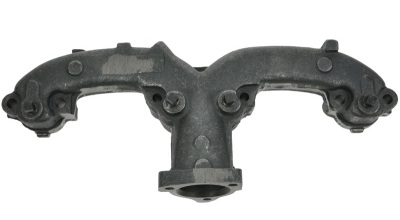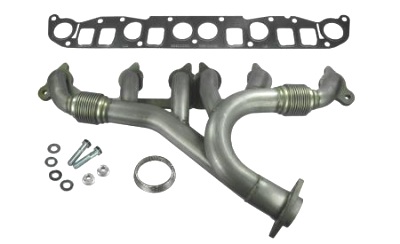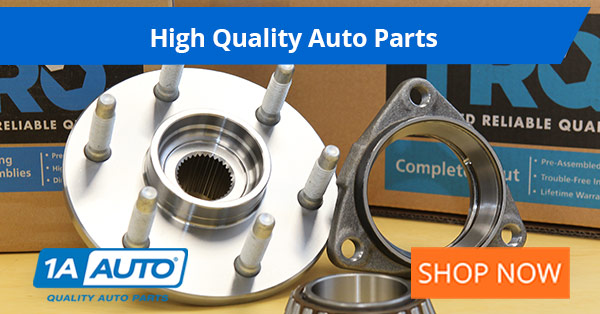Exhaust Manifolds
What is an Exhaust Manifold?
A vehicle's exhaust manifold plays the leading role in a car or truck's exhaust system. It connects to each exhaust port on the engine's cylinder head, and it funnels the hot exhaust to the exhaust pipe. With the help of the exhaust manifold gaskets, it also prevents the toxic exhaust fumes from sneaking into the vehicle and harming the occupants. Needless to say, it's pretty important to have an exhaust manifold in good working order.
The average V-shaped engine has two exhaust manifolds attached to it. One is for cylinder bank one, and the other is for cylinder bank two. The vast majority of inline engines have just one exhaust manifold. Rotary engines usually have just one exhaust manifold, though the turbocharged models have "down pipes" on the hot side of the turbo as well. Naturally there are exceptions to all of these rules, but in the real world, these exceptions are fairly rare. When it comes to the construction of exhaust manifolds, they are either going to be cast iron or welded tubular steel.
What Are Cast Iron Exhaust Manifolds?

Cast iron exhaust manifolds last a long time and they are cheap to make. That is why so many cars and trucks come with them from the factory. In modern cars, exhaust manifolds are designed to fit into small spaces and live long lives. Maximizing horsepower is rarely a factor. That is why cast iron exhaust manifolds are often replaced with more free-flowing tubular designed "headers" when the vehicle's owner is on the hunt for increased horsepower and torque. Cast iron manifolds are also heavy, and can become brittle with heat cycles and age. If they crack, the check engine light will pop on, and the vehicle will likely become embarrassingly loud. Not to mention, all of those toxic exhaust fumes would be able to escape the confines of the manifold and dance their way into the interior of the vehicle. The same thing will happen if the exhaust manifold gaskets blow out, or the mounting studs break off.
What Are Tubular Steel Exhaust Manifolds?

Since tubular steel exhaust manifolds typically have better flow, they are most often found on performance-oriented applications, like sports cars, but there are a few automotive manufacturers out there that prefer using tubular manifolds on non-sport models as well, like Jeep. This style exhaust manifold can be made from mild steel or stainless steel depending on which the car manufacturer preferred. As you can imagine, mild steel is cheaper to produce, but it won't last as long as a stainless steel exhaust manifold. The steel tubing that the manifolds are constructed with is welded to the cylinder head flange, and at all of the points where the tubing intersects. Many tubular exhaust manifolds also have built in flex-pipes that allow the different areas of the manifold to flex independently with the temperature changes. Unfortunately, like the cast iron exhaust manifolds, tubular steel manifolds crack, too.
How Exhaust Manifolds Are Different from Headers
Many people ask what the difference is between an exhaust manifold and a header. An exhaust manifold is an OEM-style part. Aftermarket exhaust manifolds look and fit just like the exhaust manifold that came on the car when it was new, with similar flow characteristics. Like we mentioned in the "cast iron" section above, exhaust manifolds are often designed with longevity and fitment in mind, not horsepower. Headers on the other hand are designed purely for maximum horsepower and torque. They are built with steel tubing, they are often mandrel bent, and most have equal length piping so that each cylinder has similar flow. Headers can be tuned to gain more or less performance in certain areas of the engine's power band. For maximum benefit, a full performance exhaust would be necessary when using headers, because great flowing headers are worthless if the pipes after them are overly restrictive.
Here is even more information on the topic of exhaust manifolds vs. headers.
What Causes a Cracked Exhaust Manifold?
A cracked or broken exhaust manifold is most often caused by one of two things: The first is heat cycles and/or age. Over time, the manifolds just can't take the heat anymore (literally and figuratively), and cracks begin to form in them. The cracks then turn into small holes, and it doesn't get any better from there. The second common reason for exhaust manifold failure is because of broken exhaust system hangers. Your whole exhaust system is supposed to be held up with a bunch of hangers. If those hangers break off, or the rubber donut exhaust hangers tear apart, all of that weight becomes the responsibility of the exhaust manifold. Sadly, they aren't built for that kind of action. Before long, they give in to the extreme weight hanging off of them, and fail in grand fashion.
The most common symptoms of a cracked exhaust manifold are:
- Visible cracks
- Extremely loud noises coming from the exhaust
- Decreased fuel efficiency and performance
- Burning smell orienting from the engine bay. You may also notice the smell from the interior of the vehicle.
In states that have emissions inspections like California, Vermont, and Massachusetts, you will find that having a cracked exhaust manifold will instantly get you a rejection sticker. That's because when you have a hole in the exhaust system, it throws off the oxygen sensor readings, and will cause your vehicle to run inefficiently. You could also lose a few miles per gallon, and be a nuisance in the neighborhood because of all the noise pollution.
How to Replace an Exhaust Manifold
Replacing an exhaust manifold will be a different procedure for each vehicle, so grabbing a service manual is a great start. That being said, there are a few noteworthy tips for replacing any exhaust manifold.
- Spray the bolts with some type of rust penetrating fluid in advance so that removing them is drama free.
- If the oxygen (O2) sensor is in the exhaust manifold, remove it before removing the manifold from the engine. Removing it once the manifold is off of the vehicle is twice as difficult.
- Removing the O2 sensor when the manifold is hot often makes it come out easier. Just be sure not to burn yourself!
- If any of the bolts are questionable looking, plan on replacing them at the same time you replace the exhaust manifold. Nuts and bolts are cheap. If you can swing the price of stainless hardware, your engine will thank you.
- Always replace the exhaust manifold gaskets when replacing a manifold. You don't want the new exhaust manifold to leak worse than the old broken one did!
- When reassembling, use anti-seize on the bolts that attach the exhaust manifold to the rest of the exhaust system. This makes bolt removal 100 times easier for the next person taking it apart.
Need a Replacement Exhaust Manifold?

As you can imagine, we have an absolutely massive selection of exhaust manifolds available. We carry the cast iron and tubular steel type, depending on the application. They are designed to look and fit just like your OEM exhaust manifolds do. Many of them even have reinforced designs that help them survive far longer than the original manifold did.
